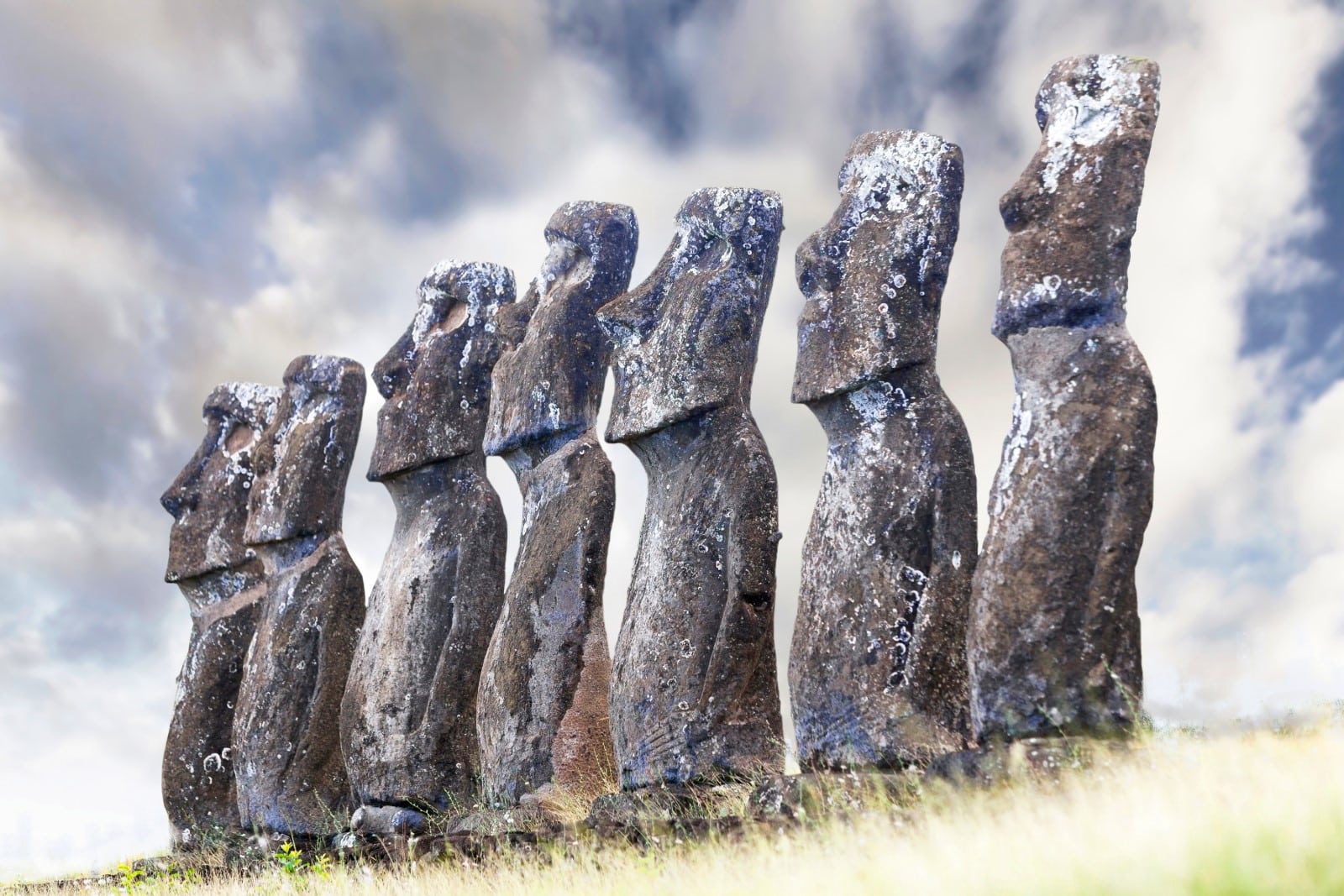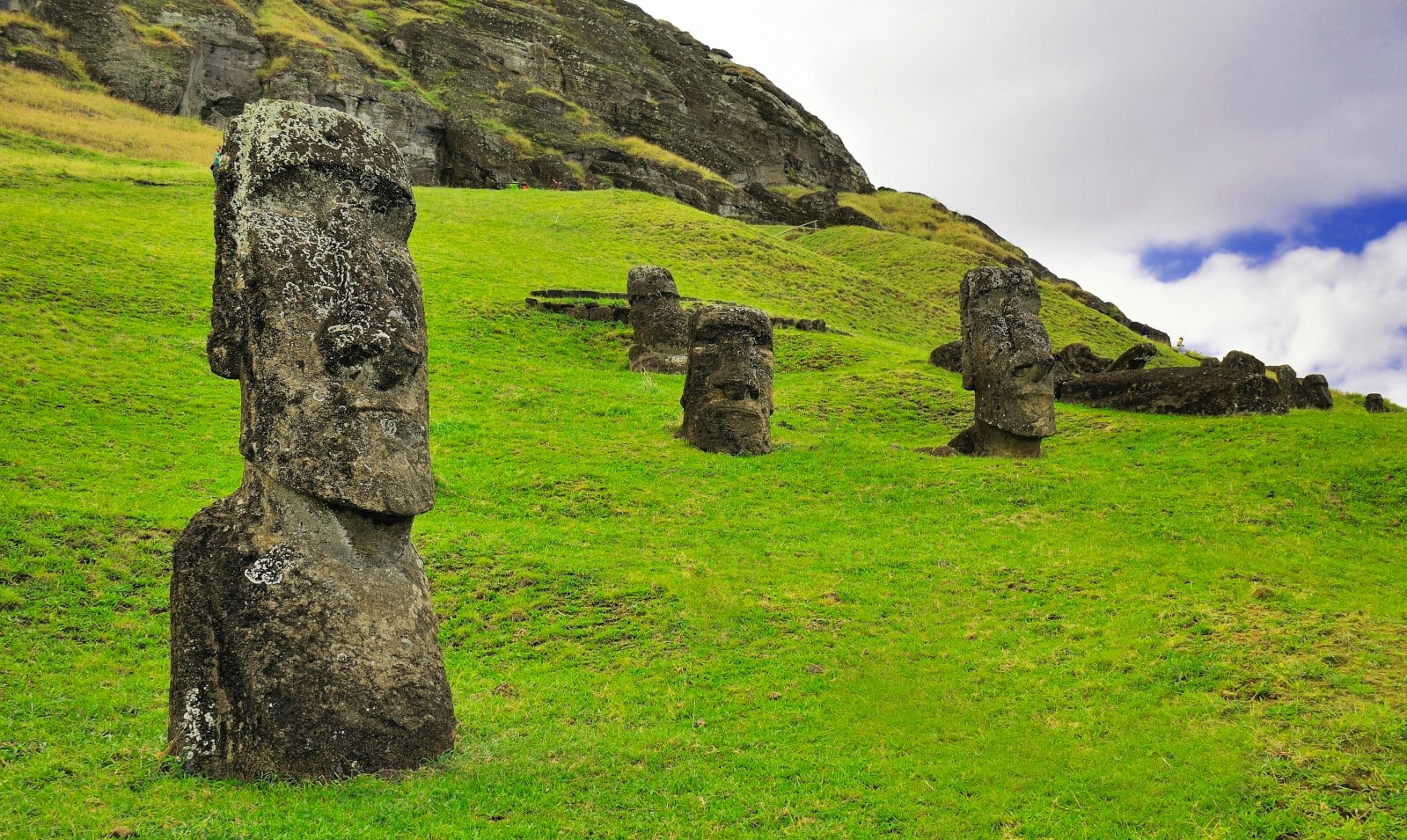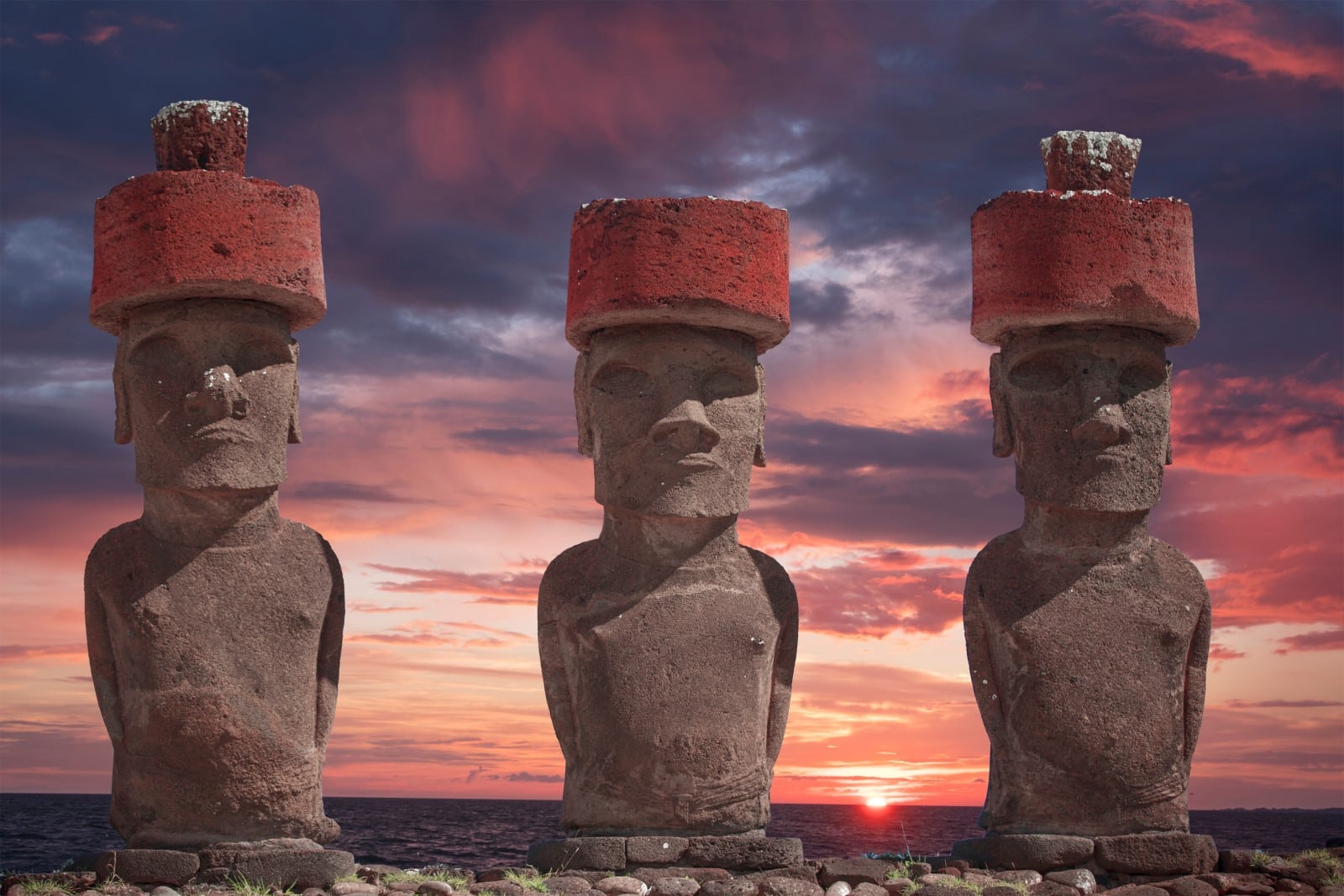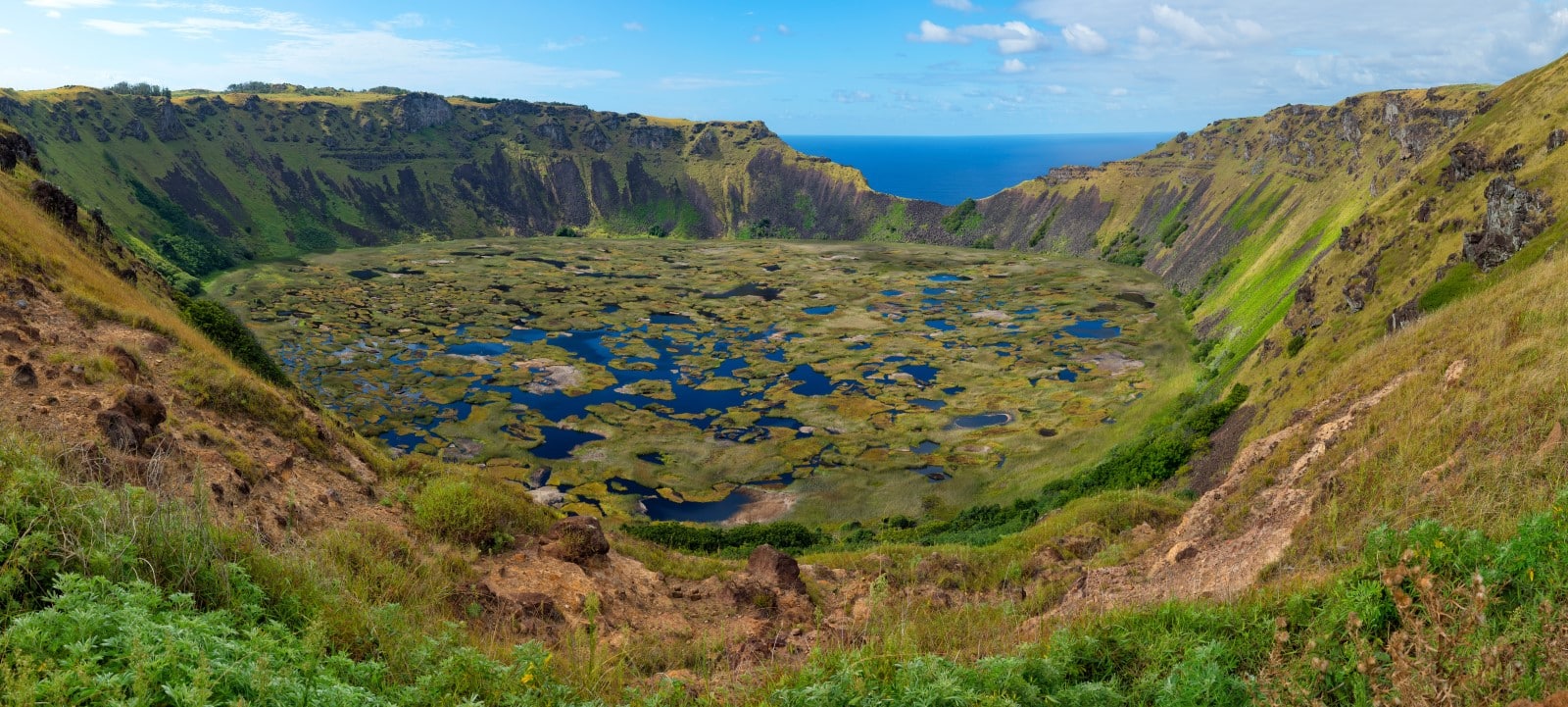
Easter Island, known as Rapa Nui to its native Polynesian inhabitants, is most famous for its nearly 1,000 monumental statues, called moai, created by the early Rapa Nui people. Inhabited around the first millennium CE, the island was discovered by Europeans on Easter Sunday in 1722, hence its name. It is one of the most isolated inhabited islands in the world, located in the southeastern Pacific Ocean.
History
Easter Island’s history can be divided into several key periods:
Settlement and Early History (c. 300–1100 CE): It’s widely believed that the island was first settled by Polynesian navigators around 300-400 CE, although some estimates suggest as late as 1200 CE. These settlers developed a unique culture, evident from the distinct language, Rapa Nui, and the construction of the moai statues.
Moai Statue Era (1100–1600 CE): The most iconic part of Easter Island’s history is the carving and erecting of the moai. These giant stone statues, some over 30 feet tall and weighing over 80 tons, are thought to represent deified ancestors. They were placed on ceremonial platforms called ahu.
Ecological Collapse and Social Change (1600–1722): The island’s population peaked at possibly more than 15,000 people, but overpopulation and overuse of natural resources led to deforestation, soil erosion, and the collapse of their ecosystem. This environmental degradation likely caused societal upheaval, warfare, and a drastic reduction in population.
European Contact and Decline (1722–1888): The first recorded European contact with the island was on Easter Sunday in 1722 by Dutch explorer Jacob Roggeveen. Subsequent visits by Europeans brought diseases to which the locals had no immunity, causing severe population decline. Additionally, Peruvian slave raids in the 1860s further decimated the population.
Annexation and Modern Era (1888–Present): Chile annexed Easter Island in 1888. Throughout the 20th century, the Rapa Nui people struggled for their rights and the return of their land, much of which was controlled by the Chilean Navy. In recent years, there has been a resurgence of Rapa Nui culture, and the island has become a significant tourist destination, known for its archaeological sites. The island was declared a UNESCO World Heritage Site in 1995, ensuring the protection and preservation of its unique historical artifacts.
Construction of the Moai
The moai statues are a significant feature of the island and a remarkable achievement given the limited resources available to their creators. These statues are carved human figures with oversized heads, often resting on massive stone platforms called ahu. Here’s how they were likely made:
- Carving: The moai were carved from tuff (a soft volcanic rock) found in the Rano Raraku quarry. The carvers used basalt stone hand chisels.
- Transportation: The transportation of these massive statues, some weighing over 80 tons, is still a subject of debate. The most widely accepted theories suggest they were either “walked” upright using ropes or moved in a horizontal position on wooden sledges or rollers.
- Erection: The moai were eventually erected on stone platforms. The process likely involved using a ramp of earth and stones, with a combination of ropes and manpower.
The population of the island reached its peak at perhaps more than 15,000 people, but then dramatically declined. There are several theories about this decline:
- Environmental Degradation: The most widely accepted theory is that the island’s inhabitants deforested the land, which led to soil erosion, reduced crop yields, and eventually a collapse in their society. The overuse of the island’s resources could have led to starvation and civil war.
- European Contact: Contact with Europeans in the 18th century brought diseases to which the islanders had no immunity, leading to a further decline in the population.
- Slave Raids: In the 19th century, Peruvian slave raids significantly reduced the population, and the introduced diseases during this time had a severe impact as well.

Deforestation and Resource Depletion
The deforestation and resource depletion on Easter Island (Rapa Nui) is a significant aspect of its history and provides a compelling case study in environmental collapse. This process played a critical role in the decline of the island’s once-thriving Rapa Nui civilization. Easter Island is one of the most isolated inhabited islands in the world, which made it more vulnerable to resource depletion.
The island originally had a subtropical forest, but its resources, including arable land, fresh water, and materials for toolmaking, were limited due to its small size and isolation.

Process of Deforestation
The Polynesian settlers used trees to build canoes for fishing and houses, which was sustainable at low population levels. The construction and transportation of the large moai statues required large amounts of wood. Trees were likely used as rollers or levers to move these massive stone statues. As the population grew, more land was cleared for agriculture, further reducing the forest cover. It’s believed that the native palm species, which were critical to the island’s ecosystem, were driven to extinction.
With the trees gone, the island’s topsoil, crucial for agriculture, was more susceptible to wind and rain erosion. Deforestation led to the loss of materials needed to build seafaring canoes, significantly reducing the islanders’ ability to fish, which was a key food source. Erosion and loss of soil fertility led to reduced crop yields, contributing to food shortages. Resource scarcity likely led to social conflicts, population decline due to warfare, and possibly even cannibalism in extreme cases.

Cannibalism
The societal collapse on Easter Island could have created dire conditions where cannibalism might have occurred. There are some historical and oral accounts that suggest cannibalism might have occurred on Easter Island, especially during periods of extreme social stress, and some of the first European visitors to the island reported accounts of cannibalism.
There is currently no conclusive archaeological evidence that clearly supports widespread cannibalism on Easter Island. While there have been some findings that could suggest cannibalistic practices, such as human bones with cut marks, these can also be interpreted in other ways, such as part of ritualistic practices or secondary burial customs.

Rano Kau Volcano and the Birdman Cult
It is a volcanic crater, part of the extinct volcano that helped form the island. Rano Kau is one of three principal volcanoes that created Easter Island, the others being Poike and Terevaka. The volcano’s crater, approximately 1 km in diameter, contains one of the island’s only three natural bodies of fresh water. Over time, the crater has partially filled with water, creating a small lake.
On the rim of Rano Kau is Orongo, a ceremonial village that was the center of the Birdman Cult, an important aspect of Rapa Nui’s late culture. The Birdman Cult, also known as the Tangata Manu, was a significant religious and cultural practice on Easter Island that emerged after the decline of the moai statue-building culture.
The central element of the Birdman cult was an annual competition to collect the first egg of the season from the sooty terns that nested on the small islets off the coast, particularly Motu Nui.
Competitors, or their representatives known as Hopu, would swim through shark-infested waters to reach Motu Nui, where they would wait for the terns to lay their eggs. The first to find an egg and return it unbroken to Rano Kau would be declared the winner. The winner of the competition would be bestowed the title of Tangata Manu, or Birdman, and was considered sacred for the duration of the year.
The Birdman cult continued until the late 19th century, declining with the advent of Christian missionaries and other external influences.
Traveler Best Hotel Picks


